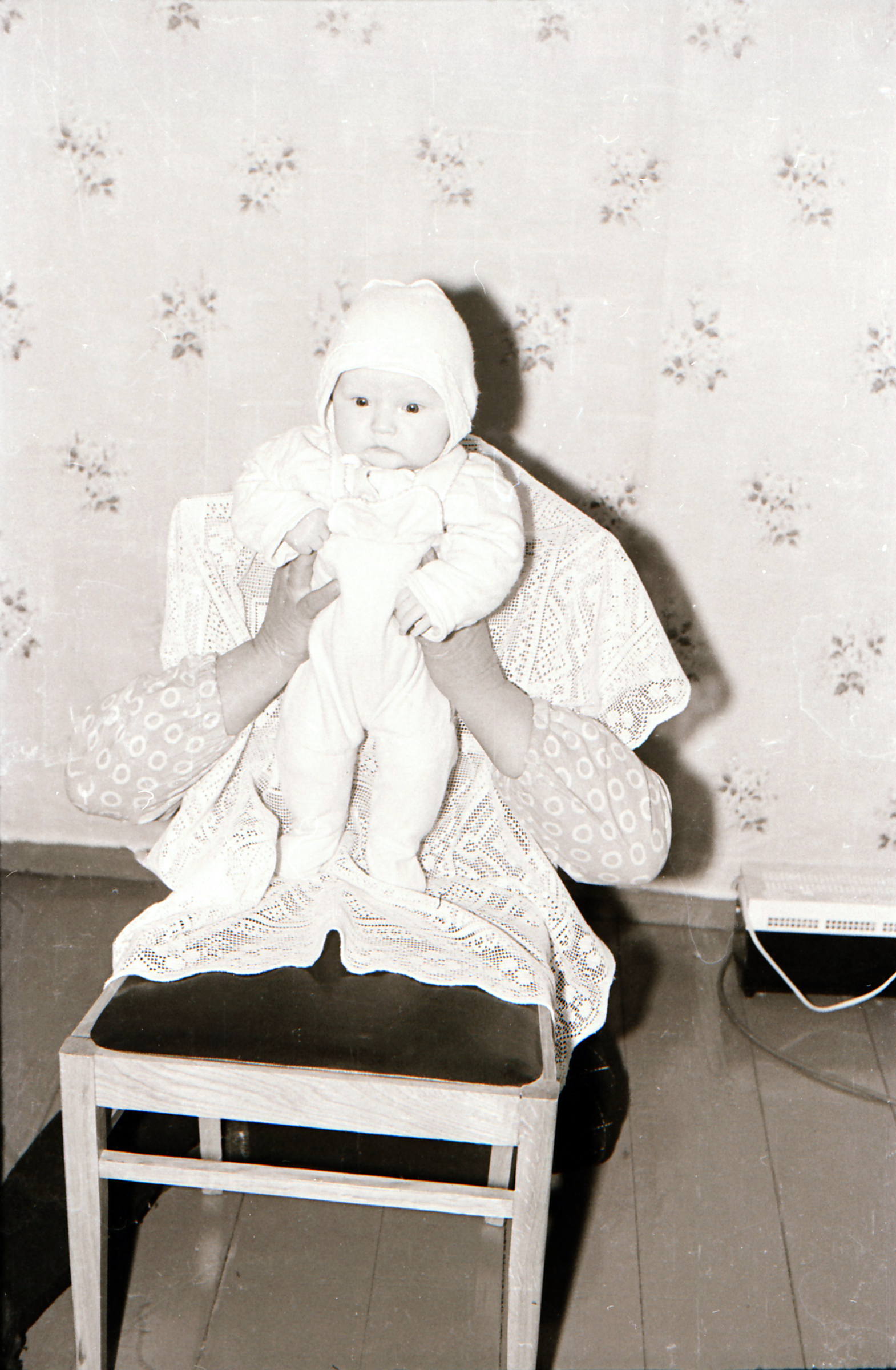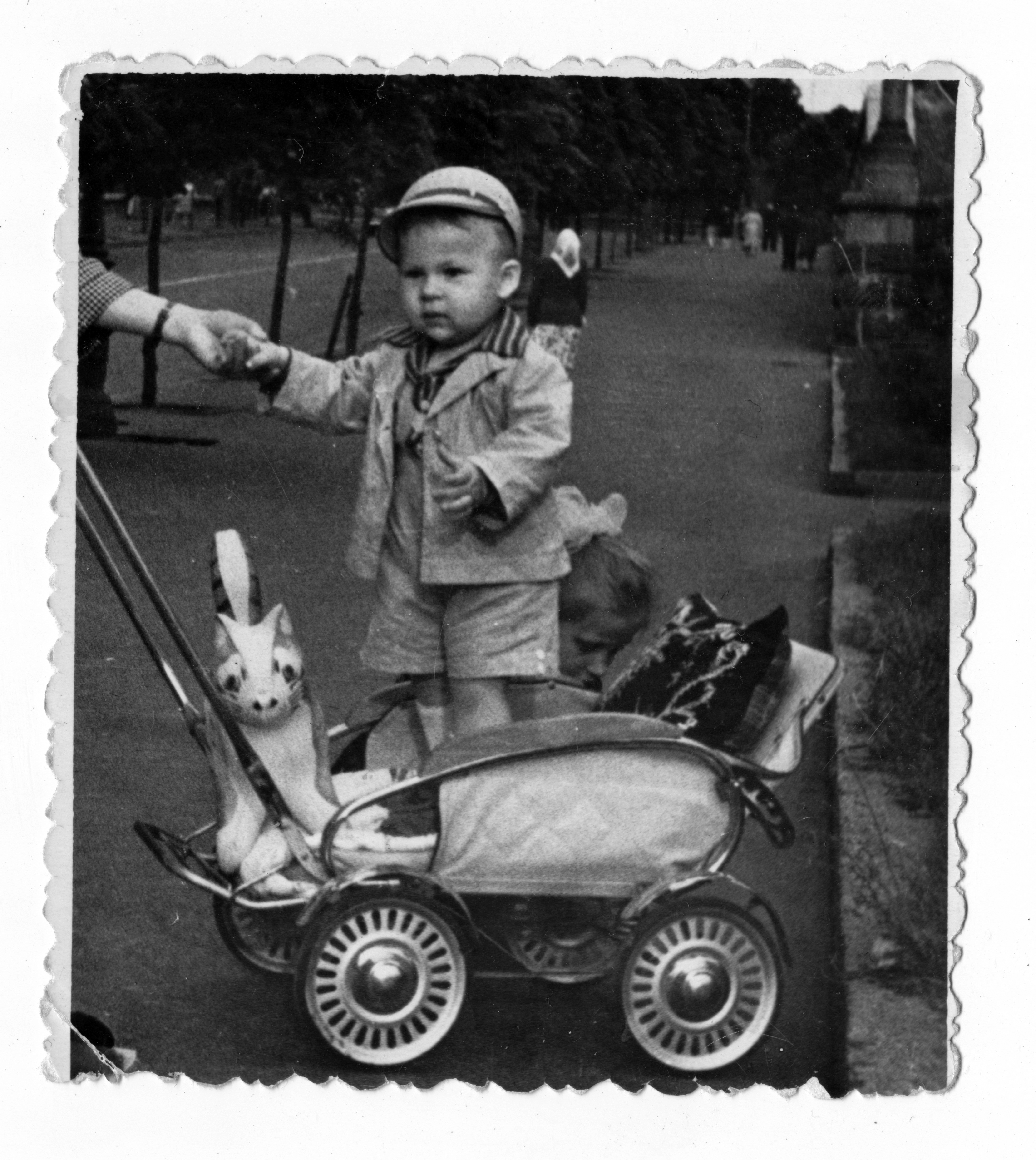СЯРГЕЙ ЛЕСКЕЦЬ i ТАНЯ КІЛІМБЕТ
Цыклы: З АДНОЙ ГЛЕБЫ / IN PAIRS
СЯРГЕЙ ЛЕСКЕЦЬ
НЯБАЧНАЯ МАЦІ
SIARHEJ LESKIEC
HIDDEN MOTHER
At the frames of the pair exhibition
by SIARHEJ LESKIEC & TANYA KILIMBET
Cycles: FROM ONE ROOT / IN PAIRS


“У студзені 2019 да мяне патрапіў архіў вясковага фатографа Мікалая Пракаповіча. Архіў на негатывах. Гэта важна, бо негатывы паказалі праўду, як думаў і працаваў фатограф. Мікалай здымаў пераважна з шыракавугольнымі аб’ектывамі (так ён лавіў больш святла на савецкую нізкаадчувальную стужку), таму ў кадрах было процьма “лішніх” дэталяў. Усе не патрэбныя элементы са здымкаў выдаляліся пры друку фотаздымка, і на выхадзе была звычайная фотакартачка з “атэлье”.
Але на сканеры “лішняе” ажывала і вяло свой расповяд. […] найболей кранулі “дотыкі і рукі” матуляў на дзіцячых здымках. Гэтага не мусіў бачыць заказчык. Бацькі хацелі якаснае дзіцячае фота, а фатограф рабіў усё магчымае, каб яго атрымаць. Арыгінальныя дзіцячыя выявы з негатываў выклікалі процьму развагаў і пытанняў. Як фатаграфічных, так і філасофскіх. Чаму, навошта так, а маці? Гэта самаахвярнасць сваім вобразам вельмі трапна распавядала аб ролі і долі нашага мацярынства.

Пытанні і развагі раслі штодня. Я працягваў пошукі і падобныя здымкі трапляліся да мяне і ў наступных архівах, аўкцыёнах. Мяне апанавала цікаўнасць калекцыянера сабраць той вобраз нашай нябачнай Мадонны”.
Сяргей Лескець
Нябачная маці
Нябачная маці
“In January 2019 I found an archive of a country photographer Mikalaj Prakapovič. The archive consisted of negatives. This is important, because negatives showed the truth, how the photographer was thinking and working. Mikalaj used mostly wide-angle lenses that helped to catch more light on low-sensitive soviet film. That is why his photos were full of “unnecessary” details. All unnecessary elements were deleted from photos during printing and in the end a usual “studio” photo came out.

However, during scanning the “unnecessary” revived and told its own story. […] what impressed me most is mothers’ “touches and hands” at the photographs of children. The client should not have seen that. Parents wanted a high-quality photo of a child and the photographer did everything possible to take it. Original images of children from negatives gave rise to lots of thoughts and questions (both photographic and philosophical). Why, for what reason, and what about mothers? This self-sacrifice of their own image perfectly demonstrated the role and fate of our motherhood.
The number of questions and thoughts was growing day by day. I continued searching and found similar photos in other archives as well. Collector’s interest to put together an image of hidden Madonna seized me.”
Siarhiej Leskiec
Hidden Mother
Hidden Mother









НЯБАЧНАЯ МАЦІ
Выстава фатаграфій з архіва Сяргея Лескеця
“Зрабіць фатаграфію маленькага дзіцяці няпроста. Няпроста нават зафіксаваць яго ў нерухомым стане больш чым на некалькі секундаў. Пазіраваць для дзіцяці зусім ненатуральная справа. Тым больш пазіраваць паасобку, бо дзіця фізіялагаічна, сентыментальна і сацыяльна яшчэ вельмі крэпка звязана з маці.
Між тым партрэтныя выявы немаўлят ўзнікаюць адразу, як узнікае фатаграфія. Здаецца, дарослыя (то бок радзіцелі) лічылі неабходным такім чынам рэпрэзентаваць сусвету свайго нашчадка, заявіць уголас пра з'яўленне новага індывідуума, новай чалавечай істоты, якая адгэтуль распачынае свой самастойный шлях у жыццё.

Аднак наколькі недарэчна, разгублена і жаласліва выглядае маленькае дзіця, знятае паасобку, нібыта страчанае ці забытае (амаль кожная і кожны з нас захаваў успамін пра той доўгі і няёмкі, зусім невясёлы момант дзяцінства, калі ты сядзіш перад фотакамерай, да слёз самотны, бо ніхто не можа і не павінен быць зараз побач з табой, нават родная маці).
Нягледзячы на відавочную ненатуральнасць прыёма, адзіночныя партэтныя здымкі немаўлят і маленькіх дзяцей рабіліся цягам усяго 20 стгодзяя, робяцца яны і сёння. Каб зрабіць падобны зымак "тэхнічна" магчымым даволі часта маці ўсё ж такі дапускалася ў кадр. Яе задачай было "зафіксаваць" дзіця, зрабіць так, каб яно не рухалася, не ўпала, не спужалася і ўвогуле не збегла прэч. А задачай фатографа было зрабіць так, каб яе прысутнасуь не была бачнай, ці, як мінімум, не кідалася у вочы з першага і нават з другога позірка. Так на фатаграфіях з'яўляюцца "нябачныя маці"
Напачатку, калі фатаграфічны працэс патрабаваў ад мадэлі доўгачасовай нерухомасці, маці часцей за ўсё цалкам прыкрывалі чорнай тканінай, саджаючы паверх накідкі, ёй на калені, дзіця. Так яна з чалавека пераўтваралася ў фон для іншага чалавека, свайго дзіцяці. Пазней, маці сталі прыхоўваць за рознымі прадметамі інтэр'ера - крэсламі, сталамі, штучнымі і натуральнымі кветкамі, падушкамі, вешалкамі і гэтак далей - тут ужо усё залежала ад фантазіі ўдзельнікаў фотасесіі і, відавочна, ад таго, якія рэчы папросту былі пад рукою (у рэшце рэшт, можна было прыкрыць маці і самім дзіцёнкам). Адным з найбольш распаўсюджаных быў "прыем з рукой", калі ў кадр пападала толькі частка матчынай рукі, якая падтрымлівала ці нават проста падбадзёрвала дзіця. Часам - у працэсе абработкі нэгатываў, фрагменты ў якіх яшчэ мажліва было разглядзець чалавечую постаць, твар, руку - адмыслова размывалі, ці ўжо постфактум, на гатовых здымках, замалёўвалі ці закрывалі іх папяровымі накладкамі.

Гэтае прывіднае існаванне маці на дзіцячых партрэтах параджае дзіўнае і трывожнае адчуванне. Здаеецца, навошта прыхоўваць тое, што прыгожа і натуральна - нежную сувязь паміж маці і дзіця? Аднак у гэтых выявах, нібыта наўмысна абрубаюцца карані, што звязваюць маленькага чалавека з продкамі, праз яго маці, ад якой застаецца, толькі фрагмент цела ці ўвогуле знікаючая цень.
З іншага боку, гэтыя выявы, нягледзячы на сваю відавочную неадназначнасць /ці хутчэй - дзякуючы ёй/ вымушаюць нас адчуць неверагодную сувязь, якая існуе паміж маці і дзіця, цягам усяго іх жыцця, у незалежнасці ад таго, наколькі простымі ці складанымі ні былі б іх адносіны, "нябачную" сувязь і бясконцую, самаадданую матчыну падтрымку, гатоўнасць у будзь-які момант працягнуць руку, падтрымаць, падхапіць, суцешыць і пры гэтым - гатоўнасць застацца ў цені, саступіць месца свайму дзіцяці, часта на шкоду сваім асабістым жаданням і мроям.
Гэткая мацярынская схільнасць да ахвярнасці, канешне, шмат у чым абумоўлена моцнай фізіялагічнай і псіхалагічнай сувяззю жанчыны са сваім дзіцяці. Але ж сацыяльныя інстытуты таксама актыўна падтрымліваюць і эксплуатуюць гэтую ўласцівасць жаночай натуры. Матчына праца - ва ўсім яе тітанічным памеры: забеспячэнне здароўя і чысціні, выхавання і адукацыі, матэрыяльнай і маральнай стабальнасці - па ранейшаму не ўспрымаецца грамадствам як сапраўдная праца. Колькі "нябачных" высілкаў, ахвяраў, фізічных і псіхалагічных рэсурсаў патрабуе мацярынства ад кожнай, што наважылася прывесці ў свет дзіця! І як часта асабістае жыццё жанчыны ( інтымнае і прафесійнае) і яе інтарэсы адыходзяць на другі план, у цэнтры яе сусвету цяпер пануе дзіця, а яе задача ад гэтага часу - любіць, падтрымліваць, абслугоўваць, забыцца пра сябе. Стаць "нябачнай"?

Так ці інакш, гэтыя ўтылітарныя фатаграфіі, зробленыя без якой-небудзь першаснай мастацкай задумы, пабачаныя разам, у масе, не толькі ўражваюць і кранаюць, але ставяць перад гледачамі шматлікія пытанні, то бок ўздзейнічаюць як сапраўдныя творы мастацтва”.
Лізавета Міхальчук, студзень 2020
HIDDEN MOTHER
Photo exhibition from Siarhiej Leskiec’s archive
“It is not easy to take a photo of a baby. It is not easy even to fix it still for more than a couple of seconds. Posing is a very unnatural thing for a baby. Especially when posing alone, because a baby is still very much connected physiologically, emotionally and socially with a mother.

Meanwhile, portraits of babies appear as early as photography itself. It seems that it was important for adults (i. e. parents) to present their offspring to the world in such a way, to announce the coming to life of a new individual, a new human being who from now on began its own journey of life.
However, how absurdly, perplexedly and piteously a baby looks when photographed alone. As if it is lost and forgotten. Almost all of us have a childhood memory when you sit in front of the camera sad to tears, because no one can and is allowed to be with you at the moment, even your own mother.
In spite of the evident unnaturalness of this genre, single portraits of babies were taken throughout the 20th century and they are still taken today. In order to make such a photo “technically” possible quite often mother was allowed into the frame. Her task was to “fix” a baby, to prevent it from moving, falling or becoming frightened and running away. The photographer’s task was to hide her presence or at least to make it unrecognisable at first and even second glance. That is how “hidden mothers” appear on photographs.

At the beginning, when photographic process required a model to stay still for a long time mothers were often hidden under a black cover with a child sitting on her knees on top of the cover. As a result, she turned from a human into background for another human, namely her child. Later, mothers started hiding behind different interior objects: armchairs, tables, artificial and natural flowers, cushions, stands, etc. Here everything depended on the creativity of the participants of a photo shoot and of course simply on what was at hand (in the end mother could be covered by a baby itself). One of the most widely spread was a “trick with a hand” when only a part of the mother’s hand supporting or just cheering up a baby got into a frame. Sometimes during the processing of negatives parts where one could still see a human figure, face or hand were blurred on purpose. Alternatively, already post factum they were covered with drawings or paper.
This ghostly existence of a mother at the portraits of babies gives rise to a strange and anxious feeling. Surprisingly, why hiding something that is beautiful and natural, namely a tender connection between a mother and a baby? However, at these photos as if on purpose the roots that connect a small human with ancestors through a mother are cut. Only a part of body or a disappearing shade is left from her.

On the other hand, in spite of obvious ambiguity (or rather thanks to it) these images make us feel an incredible connection that exists between a mother and a child through all their lives regardless of how easy or complicated their relations are. They make us feel a “hidden” connection and mother’s endless self-sacrificing support, readiness to lend a hand at any moment, to support, to seize, to comfort and at the same time readiness to stay in shade, to let a place to her child often irrespective of her own wishes and dreams.
This tendency to self-sacrifice that mothers have is doubtlessly to a large extent conditioned by a strong physiological and psychological connection between a woman and her child. However, social institutions also actively support and exploit this peculiarity of women’s nature. Mother’s work enormous in size (ensuring health care and cleaning, upbringing and education, material and mental stability) is still not perceived as real work in the society. How many “hidden” efforts, sacrifices, physical and psychological resources does motherhood require from everyone who takes courage to bring a child into the world! How often women’s personal life (intimate and professional) and her interests move to the background. A child is now in the centre of her universe and her aim from now on is to love, to support, to serve, to forget about herself. To hide herself?
Nevertheless, when we see these utilitarian photographs taken without any primary artistic idea all together as a mass, they not only impress and touch but also pose numerous questions to viewers, i.e. affect as real works of art.”
Lizaveta Mikhalchuk, January 2020













Сяргей Лескець, фатограф, гісторык, этнограф. Нарадзіўся ў 1984 годзе ў Турэц-Баяры на Маладзечаншчыне. Скончыў гістарычны факультэт Беларускага дзяржаўнага педагагічнага універсітэт імя Максіма Танка і аддзяленне найноўшай гісторыі Беларускага калегіума. У творчасці аддае перавагу тэмам традыцыйнай культуры, сямейных каштоўнасцяў, паўсядзённага жыцця. Жыве і працуе ў Беларусі.
Siarhej Leskiec, photographer, historian, ethnographer. Born in 1984 in Turetz-Bayary (Maladzeczna region, Belarus). He received a history degree from Belarusian State Pedagogical University. Currently he is a freelance photographer whose work focuses on everyday life, folk traditions, and rituals in the Belarusian countryside. Lives and works in Belarus.